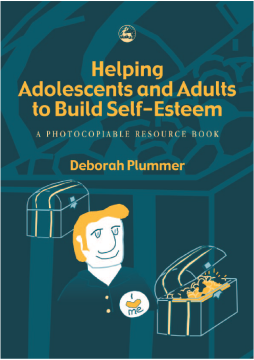
Additional Information
Book Details
Abstract
A healthy level of individual self-esteem is the foundation for emotional, physical and social well-being. People who value themselves and who recognise their own skills are likely to live fulfilling and rewarding lives and will tend to attract genuine liking and respect from others. Conversely, low levels of self-esteem have been linked with such personal and social concerns as school failure, depression, social anxiety, violence and substance abuse. Helping Adolescents and Adults to Build Self-Esteem follows on from the widely acclaimed Helping Children to Build Self-Esteem. It is filled with simple, practical and innovative ideas for supporting the development and maintenance of healthy self-esteem. Based on the author's clinical experience, the easy-to-use photocopiable activity sheets encourage participants to draw on existing skills and to develop new approaches to building confidence and feelings of self-worth. These exercises are suitable for work with individuals and with groups, and will prove an indispensable aid to building self-esteem in adolescents and adults.
Table of Contents
| Section Title | Page | Action | Price |
|---|---|---|---|
| Foreword to second edition ix | |||
| Foreword to first edition x | |||
| 1. Nature's own building material 1 | |||
| Early use 1 | |||
| Advantages of stone 4 | |||
| The future of stone 7 | |||
| 2. Stone materials 10 | |||
| Terminology 10 | |||
| Rock types 12 | |||
| Sedimentary rocks 13 | |||
| Seasoning 14 | |||
| Weathering 15 | |||
| Insulation 16 | |||
| Porosity 16 | |||
| Florescence 17 | |||
| Strength 18 | |||
| Weight 20 | |||
| Hardness 20 | |||
| 3. Stone sources 23 | |||
| Locating stone 23 | |||
| Types of deposit 24 | |||
| Boulder resources 26 | |||
| Sorting shapes 28 | |||
| Identification of deposit 29 | |||
| Further exploration 29 | |||
| Surface features of stone deposits 32 | |||
| 4. Stone extraction 41 | |||
| Quarry planning and development 41 | |||
| Location 42 | |||
| Opening up quarries 43 | |||
| National planning and inventory 43 | |||
| Preparation and extraction 46 | |||
| Slabby layers 49 | |||
| Extraction devices 50 | |||
| Raising blocks from the quarry floor 54 | |||
| Transport 55 | |||
| 5. Stone and the environment 59 | |||
| The effects of quarrying on the environment 60 | |||
| Case study: Olival quarry 64 | |||
| Case study: Estremoz quarry 65 | |||
| Case study: Ontario 65 | |||
| Effects of the environment on stone 68 | |||
| 6. Tools for stoneworking 73 | |||
| Terminology 73 | |||
| Tools and techniques 73 | |||
| Splitting devices 75 | |||
| Sizing sedimentary stones 77 | |||
| Splitting 78 | |||
| Hammers 79 | |||
| Chisels 82 | |||
| Drills 84 | |||
| Saws 85 | |||
| Bars 85 | |||
| Stone-breaking 90 | |||
| Hand-cutting a plane surface 90 | |||
| 7. Architectural uses 95 | |||
| Types of building stone 95 | |||
| Types of dressing 96 | |||
| Masonry practices 98 | |||
| Field-stone construction 101 | |||
| Building a wall 104 | |||
| Construction of dwellings 109 | |||
| Foundations 109 | |||
| Walls 113 | |||
| Stone as a roof covering 116 | |||
| Arches 119 | |||
| Floors 121 | |||
| 8. Industrial production 125 | |||
| Quarrying practices 127 | |||
| Drilling methods 127 | |||
| Wire-sawing 128 | |||
| Extraction by chain-saw 129 | |||
| Flame-jet cutting 130 | |||
| Water-jet cutting 131 | |||
| Processing 131 | |||
| Primary cutting 132 | |||
| Secondary sawing 136 | |||
| Surface processes 137 | |||
| Gritting 138 | |||
| Finishes 139 | |||
| Polishing 140 | |||
| Fixing 142 | |||
| Automation 143 | |||
| Waxing and packing 145 | |||
| 9. Stone development 150 | |||
| Comparative costs 150 | |||
| Planning 151 | |||
| Investing in equipment 152 | |||
| Commercial factors 153 | |||
| Pricing 154 | |||
| Transport 154 | |||
| Promotion 155 | |||
| Statistics for the future 158 | |||
| Foundations of success 159 | |||
| Appendix: Stone testing 162 | |||
| Current situation 162 | |||
| Testing procedures 162 | |||
| Safety factor 164 | |||
| Durability 164 | |||
| Surface finish 165 | |||
| Bibliography 167 | |||
| Glossary 168 |
